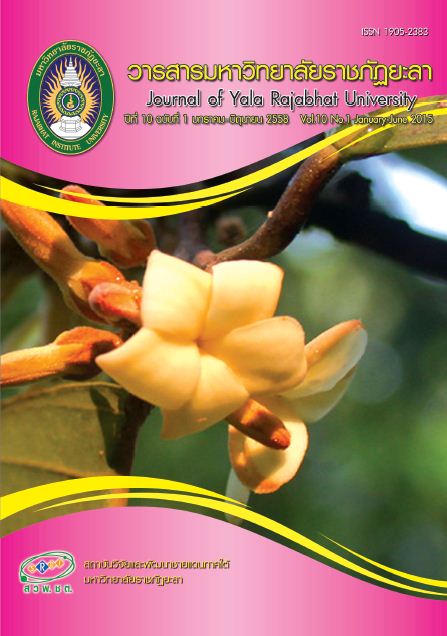เรณูวิทยาของนํ้าผึ้งในอำเภอเมือง จังหวัดยะลา
Main Article Content
บทคัดย่อ
นํ้าผึ้งเป็นผลผลิตธรรมชาติที่ผึ้งเก็บรวบรวมนํ้าหวานจากต่อมนํ้าหวานของพืชที่หลากหลายชนิดมาเก็บไว้ในรัง อย่างไรก็ตาม ผึ้งยังเก็บเรณูของพืชด้วยเช่นกัน จากลักษณะของเรณูที่แตกต่างกันนั้นสามารถจำแนกพืชชนิดต่างๆ และบ่งบอกถึงความหลากหลายของพืชได้การศึกษาเรณูวิทยาของนํ้าผึ้งที่เก็บจากรังผึ้งในศูนย์เศรษฐกิจพอเพียง อำเภอเมือง จังหวัดยะลา ระหว่างเดือนมกราคมถึงธันวาคม พุทธศักราช 2553 เรณูในนํ้าผึ้งถูกจำแนก บรรยายลักษณะและถ่ายภาพใต้กล้องจุลทรรศน์ พบว่า เรณูในนํ้าผึ้งทั้งหมดมี 28 ชนิด เรณูที่พบส่วนใหญ่มีรูปร่างแบบ Spheroidal มีขั้วแบบ Isopolar มีช่องเปิดแบบ Tricolpate มีลวดลายแบบ Psilate และมีขนาด (P x E) ระหว่าง 3.43-54.98 × 5.76-61.33 ไมครอน ดังนั้น ลักษณะเรณูในนํ้าผึ้งที่แตกต่างกันสามารถบ่งบอกความหลากหลายของพืชและแสดงความอุดมสมบูรณ์ของสิ่งแวดล้อมได้ รวมทั้งสามารถจำแนกพืชได้ในอนาคตต่อไป
Article Details
บทความ ข้อมูล เนื้อหา รูปภาพ ฯลฯ ที่ได้รับการเผยแพร่ในวารสารมหาวิทยาลัยราชภัฏยะลานี้ ถือเป็นลิขสิทธิ์ของวารสารมหาวิทยาลัยราชภัฏยะลา หากบุคคลหรือหน่วยงานใดต้องการนำทั้งหมดหรือส่วนหนึ่งส่วนใดไปเผยแพร่ต่อหรือกระทำการใดๆ จะต้องได้รับอนุญาตเป็นลายลักษณ์อักษรจากวารสารมหาวิทยาลัยราชภัฏยะลาก่อนเท่านั้น
เอกสารอ้างอิง
2.สิริวัฒน์ วงษ์ศิริ .(2539). ชีววิทยาของผึ้ง. กรุงเทพฯ : มหาวิทยาลัยจุฬาลงกรณ์.
3.Agwu, C. O. C., Obuekwe, A. I. and Iwu, M. M. (1989). Pollen analytical and thin layer chromatographic examination of Nsukka (Nigeria) honey. Pollen of Spaces, 31,
29–43.
4.Baum, K. A., Rubink, W. L., Coulsonand, R. N. and Bryant, V. M. (2011). Diurnal patterns of pollen collection by feral honey bee colonies in southern Texas. USA.
Palynology, 35, 85–93.
5.Bilisik, A., Cakmak, I., Bicakci, A. and Malyer, H. (2008). Seasonal variation of collected pollen loads of honeybees (Apis mellifera L. anatoliaca). Grana, 47, 70–77.
6.Corbet, S. A. (1978). Bee visits and the nectar of Echium vulgare L. and Sinapsis alba L. Ecological Entomology, 3, 25–37.
7.Erdtman, G. (1960). The acetolysis method–A Revised Description. In Svensk. Bot. Tidskr., 54, 561–564.
8.Faegri, J. and Pijl, L. V. D. (1979). The Principles of Pollination Ecology. London: Pergamon Press.
9.Hegland, S. J., Nielsen, A., Lazaro, A., Bjerknes A. L. and Totland, O. (2009). How does climate warming affect plant-pollinator interactions?. Ecology Letters, 12, 184–195.
10.Ige, O. E. and Obasanmi, O. O. (2014). A palynological assessment of honey samples from Delta State, Nigeria. American International Journal of Biology, 2, 47–59.
11.Lieux, M. H. A. (1972). Melissopalynological study of 54 Lovisianan (USA) honey. Review Paleobotany and Palynology, 13, 95–124.
12.Mear, N. T. (1985). Pollen analysis of New Zealand honey. New Zealand Journal of Agricultural Research, 28, 39–70.
13.Moore, P. D., Webb, J. A. and Collinson, M. E. (1991). Pollen Analysis (second edition). Oxford: Blackwell Science.
14.Monselise, S. P. (1986). CRC Handbook of Fruit Set and Development. Florida: CRC Press.
15.Romas, S. E., Perez, B. M. and Ferreros, G. C. (1999). Pollen characterization of multifloral honeys from La Parma (Canary Islands). Grana, 38, 133–140.
16.Sajwania, A., Farooqa, S. A. and Bryant, V. M. (2014). Studies of bee foraging Plants and analysis of pollen pellets from hives in Oman. Palynology, 38, 207–223.
17.Scaven, V. L. and Rafferty, N. E. (2013). Physiological effects of climate warming on flowering plants and insect pollinators and potential consequences for their interactions. Curr Zool., 59, 418–426.
18.Shubharani, R., Roopa, P. and Sivaram, V. (2013). Pollen morphology of selected bee forage plants. G.J.B.B., 2, 82–90.
19.Sofia, N. (2004). Pollen analysis of honey from the region of two villages in West Bulgaria. Phytologia Balcanica, 10, 247–252.


